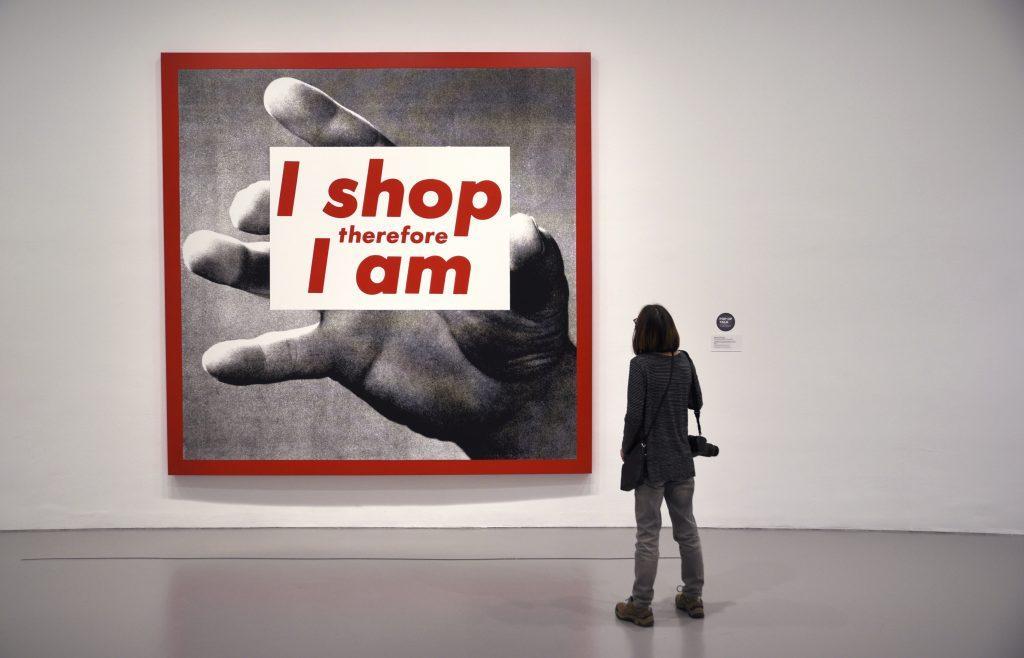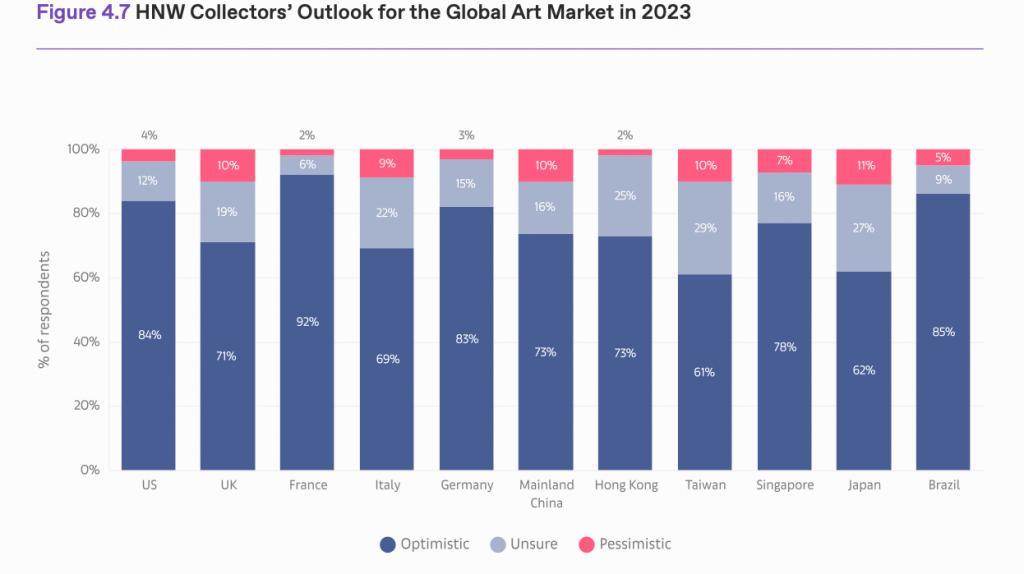(MENAFN- USA Art News) This week in the Back Room: an art-market logistics mystery, big trouble at big auction houses and museums, extra-sunny buyer psychology, and much more- all in a 6-minute read (1,764 words) .
__________________________________________________________________________
Top of the Market Hold, Please

Barbara Kruger's I Shop Therefore I Am at the Hirshhorn Museum. (Photo by Robert Alexander/Getty Images)
Every art pro is familiar with stories of deadbeat collectors refusing to pay for works they've committed to buy. But a weirder wave of unfinished transactions has been sweeping the industry lately: works paid for promptly but not picked up for months or, sometimes, even years.
Sound unreal? Our colleague Katya Kazakina had the receipts (literally, in some cases) in last week's Art Detective . A few examples she unearthed included...
A museum trustee who agreed to buy a $550,000 Robert Nava painting over drinks at New York club Zero Bond last year, wired the money to the seller the next day-then didn't bother getting the work for seven months.
A partner at David Zwirner who paid $22,000 for a 7.5-foot-tall Richard Serra print at an Independent Curators International charity auction in 2018-but was too busy to pick it up until 2022.
Two commissioned paintings, each priced about $28,000, that are still waiting to be collected from the Los Angeles studio of artist Canyon Castator months after being completed, paid for, and prepped to ship.
“I first interpreted this trend as a sign of a slowdown in the art market, the froth coming off-or maybe the low tide that exposes all the broken shells and mollusk skeletons on the now-visible ocean floor,” Katya wrote. But her sleuthing revealed that the phenomenon has multiple and varied origins outside any particular moment in the business cycle.
Three main causes emerged from her reporting, starting with...
Obsessive-Compulsive Behavior
Within the art world, buying more work than you can display is a badge of honor that's also regularly (and paradoxically) labeled an addiction. Sometimes, the designation is more than just a euphemism.
Allen H. Weg , executive director of the obsessive-compulsive-disorder treatment center Stress and Anxiety Services of New Jersey , confirmed that any behavior can be addictive if it provides a powerful enough emotional experience-including buying art.
This is especially true if the behavior leads to an experience of elation, victory, or control. All three can (and do) manifest frequently in an acquisitions game centered on buying beautiful objects, identifying underappreciated value, and/or beating rivals to the trophy.
Weg even role-played the obsessive-compulsive mentality that could be at play for collectors who buy but wait ages to pick up:“It's mine. I have control over it. I don't necessarily need it to be this place or that place. I just know it's mine wherever it is.”
Whether it qualifies as an addiction or not, buying at scale can cause rampant collectors to genuinely lose track of their own activity, leaving works unclaimed for extended periods even after they're free and clear to be delivered.
Liquidity and Tax Issues Although high net worth individuals can usually buy whatever they want, whenever they want, they are also on near-perpetual alert for any additional value they can extract from the timing or structure of their transactions. This principle extends to art purchases.
Maybe waiting to ship a paid-for artwork carries tax advantages, particularly if the buyer shifts around other assets beforehand. Maybe a collector can't (or won't) accommodate a major work without either making pricey renovations to its intended home first, or paying hefty expenses for a specialty install (think: having to remove windows and crane an oversized painting into a high rise).
No matter what the reason, substantially more cash might need to be spun out of other assets before collecting an artwork is financially defensible to buyers. As attorney Thomas Danziger said,“Many of the richest people in the world are not liquid.”
Penny-pinching
Other times, however, this odd trend really does just boil down to frugality, if not outright stinginess.
Francisco Correa Cordero , owner and director of Lubov gallery in New York, said he wasn't thrilled when China 's Xiao Museum left behind a group of eight purchased paintings for seven months. Still, he understood when he learned that the museum's founder had gone on a shopping spree in New York and was waiting to consolidate all their artworks into one massive shipment.
Whether or not there's a semi-defensible reason, saddling galleries or nonprofits (especially smaller ones) with already-sold art for extended stretches can cause real problems. Few have enough square footage to act as free storage units.
Yet that's what buyers who delay shipping transform galleries into-often because it means they don't have to pay for storage themselves in the interim.
__________________________________________________________________________
The Bottom Line The ultimate irony of long-postponed art pickups is that understanding buyers' reasoning changes nothing about artists and dealers' options for action. Aggressive follow-up, let alone doing something as extreme as charging a client for storage, risks damaging a potentially lucrative relationship forever. Even major auction houses have been known to absorb long-term storage fees for big buyers.
Ultimately, for most sellers it's still better to eat some extra costs than, as Castator said, to“bite the hand that feeds you.” And buyers know it, too.
[read more ] ____________________________________________________________________________
Paint Drippings This week's Wet Paint was still being mixed at delivery time for this newsletter, so here's what else made a mark around the industry since last Friday morning...
Art Fairs
The inaugural Tokyo Gendai fair, co-founded by Magnus Renfrew , announced the 79 dealers that will exhibit at the Pacifico Yokohama July 7–9, ranging from blue-chippers Blum and Poe and Sadie Coles HQ , to homegrown Tokyo spaces Gallery Common and Scai the Bathhouse . ()
The 25th edition of Art Paris welcomed nearly 82,000 visitors to the Grand Palais Éphémère last week, a roughly 20 percent increase over last year's attendance. ()
At last week's first ever Unrepresented Fair in Paris , 13 artists and one artist duo-all lacking gallery representation for their photo-based work-exhibited directly to buyers thanks to patrons' support. The fair's second edition is scheduled to open at the Molière in April 2024. ()
Auction Houses
Market activity at the 14th edition of Asia Week New York easily bested last year's edition, with 22 out of the 26 galleries and five out of the six auction houses reporting a grand total of $131.7 million worth of sales as of March 31. Highlights included Christie's sale of a rare version of Katsushika Hokusai 's for a record $2.8 million . (artnet news )
British auditors cast“significant doubt” on the financial survival of Phillips after reviewing the mounting debts owed to the Russian-owned auction house amid the continuing war in Ukraine. ()
The U.K. 's leading auction house for gender equity in wages is Bonhams , according to the latest annual pay gap report for the sector. Women at Bonhams are paid 92 pence for every £1 earned by men in similar roles-almost 25 percent more than at Christie's ( 74 pence ) and Sotheby's ( 73 pence ). ()
Galleries
LA Vandyke left her post at David Zwirner to become a director at rising gallery Amanita (New York / Florence); Greene Naftali promoted Jeffrey Rowledge and Martha Fleming-Ives to partner, plus hired Cory Nomura , a Matthew Marks veteran, as senior director. (wet paint, )
Pace now reps Grada Kilomba (in collaboration with Goodman Gallery ), while Margot Samel (NYC) rostered five new artists: Olivia Jia , Kris Lemsalu , Sarah Margnetti , Narcissister , and Stephen Polatch . (, Wet Paint)
In British gallery debuts: Angelica Jopling , daughter of White Cube founder Jay Jopling , opened a new space called Incubator (which she said is“totally siloed” from her father's business) in Marylebone, London; and Bo Lee and Workman , a new gallery co-founded by Jemma Hickman and former Hauser and Wirth senior director Alice Workman , will debut in a former church in Bruton, Somerset on May 18. ()
Institutions
Jenny Schlenzka left her post as executive artistic director of Performance Space to become director of the exhibition hall at Berlin's Gropius Bau . ()
The Met announced that it will return 15 sculptures associated with disgraced dealer Subhash Kapoor to the government of India, while investigators seized an ancient bronze from the museum's collection after concluding that the work (estimated to be worth $25 million ) had been looted from Turkey in the 1960s. ()
Obituaries and Legal News
Ted Bonin , the veteran New York dealer who co-founded Alexander and Bonin en route to helping turn a diverse set of artists into institutional mainstays, died of natural causes at his home in Manhattan on Tuesday. He was 65. (artnet news )
An attorney for Belgian mega-collector Guy Ullens said her client is suing his son Nicolas Ullens , who is suspected of fatally shooting his mother-in-law , Myriam Ullens , last month. Reports say that Guy's children had been trying to prevent his wife from disinheriting them. ()
____________________________________________________________________________
Data Dip
More Than a Feeling?

© Arts Ecoomics 2023, courtesy of Art Basel and UBS.
This week, Art Basel and UBS released the 2023 edition of Clare McAndrew 's annual quantitative report on the state of the industry. The headline is that global art sales were estimated to have ticked up to $67.8 billion in 2022, an increase of 3 percent year over year. But given the importance of sentiment to this eternally subjective trade, I'm most interested in the data from the report's August 2022 survey of more than 2,700 high net worth art buyers across 11 regional markets.
The main takeaway? Even after eight rough months for the investor class, most wealthy people in the sample still felt awfully good about the art market's prospects in 2023...
In aggregate, 77 percent of all HNW respondents said they felt positive about the year ahead in the art trade.
By regional market, France had the largest share of optimists, at 92 percent , while Taiwan had the smallest, at 61 percent .
Among the three perennial regional leaders in annual art sales, the U.S. counted a significantly higher proportion of optimistic HNWs ( 84 percent ) than the U.K. ( 71 percent ) or greater China ( 73 percent each on the mainland and in Hong Kong ).
Eight months later, there's no telling how many respondents still feel sunny about the art market's near future. But since booms and panics alike are powered by beliefs more than by facts, this global wave of optimism helps explain one important reason that art sales have stayed so resilient amid so much other bad news.
[read more ] ____________________________________________________________________________
Thanks for joining us in the Back Room . See you next Friday.






















Comments
No comment